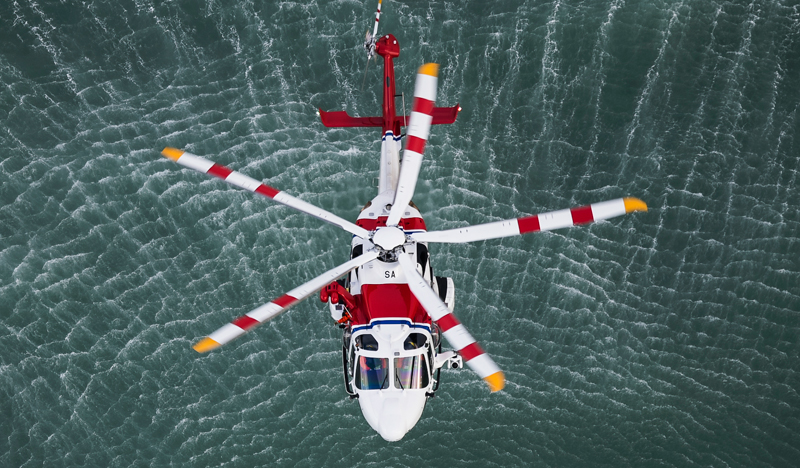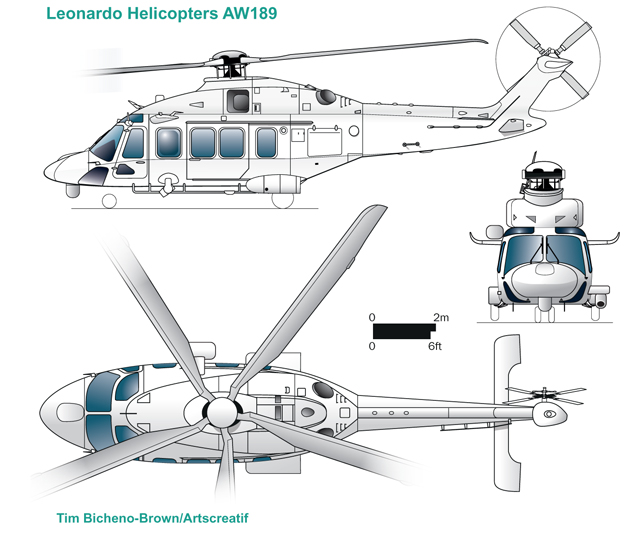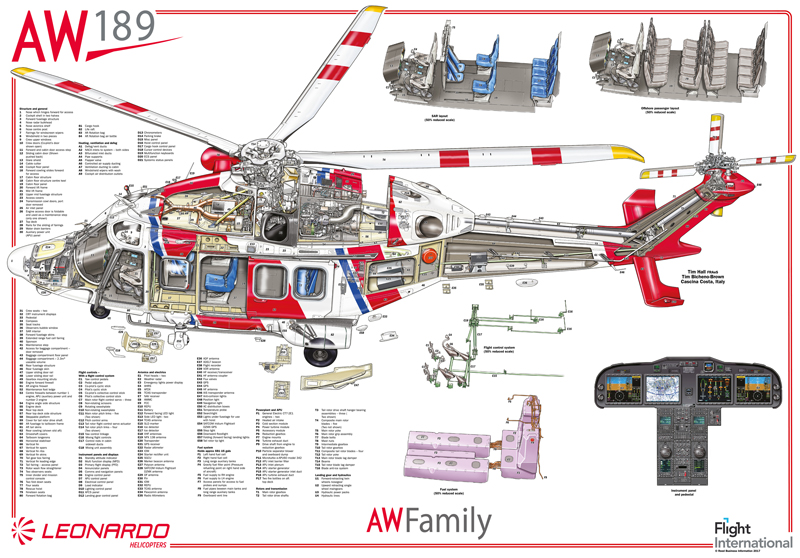Inside a cavernous factory in Vergiate, northern Italy, rows of helicopters stand in various stages of final assembly.
Surrounded by scaffolding and workbenches, they range from carbonfibre shells – empty save for dangling wiring looms – to aircraft ready for flight.
Every few days the airframes advance to the next station of the assembly line, all the while drawing nearer to completion.
The Vergiate plant is a piece of Italy’s aerospace industrial heritage that, since its construction in 1937, has produced everything from military transports to, in the period after the Second World War, buses and motorbikes.
But as the main final assembly facility for Leonardo Helicopters, the plant’s output is now solely rotorcraft.
All the manufacturer’s principle models are produced here (the exception being the AgustaWestland AW119Kx light single) varying in size from the AW109 to the AW139 intermediate twin and the AW189 super-medium – currently the largest helicopter the airframer produces.
For a number of years, the AW139 represented the biggest slice of Vergiate’s output – and the site’s customer delivery centre is still full of the intermediate twins – but a sizeable chunk of the factory’s 365m (1,200ft) length is now given over to the larger AW189.

Leonardo Helicopters
Main rotor blades claim a world first use of anti-vibration inertial self-damping technology
Where the AW139 has a six-stage line that moves every eight days, the AW189’s six-stage line advances every 11 days.
Pietro Narcisco, who manages the Vergiate plant, says that despite their external similarity – at a glance, the main difference is the number of side windows – there is a pronounced divergence in how the two types are built.
“It [the AW189] is a more complex aircraft; it is not simply 20% larger. It is a different kind of aircraft for a different kind of mission. In terms of complexity the AW189 can be compared to the [NH Industries] NH90,” he says.
Perhaps that is as good a description as any for the AW189: simple on the outside, internally highly complex.
To some extent, that can be explained by the helicopter’s genesis. It started life in 2009 as the AW149 – a new intermediate-weight military helicopter pitched as an alternative to the Sikorsky UH-60 Black Hawk.
Actually, explains chief engineer Fabio Nannoni, the programme’s first prototype was a curious hybrid, featuring the drivetrain and dynamic components from the AW139, coupled to the fuselage and avionics of the AW149.
That first flight milestone came in 2009, but it was not until two years later, at the 2011 Paris air show, that the AW189 was launched by the then AgustaWestland.
With the AW149 failing to register a sale until 2016, Leonardo has faced inevitable accusations that the launch of the AW189 was simply an attempt to recoup some of its otherwise wasted investment.
But Roberto Garavaglia, senior vice-president of strategy and business development, denies that suggestion. “It was not [launched] because we were not selling the AW149,” he says. “It was an opportunity that we seized at the same time.
“Making the AW189 was low-hanging fruit from the original concept of the AW149.”

Market research and conversations with customers, particularly those operating offshore oil and gas missions, had indicated demand for a new class of helicopter, he says. They envisaged a machine that would fit into a gap between the 12-passenger, 6.4t AW139 and heavier 19-passenger rotorcraft such as the Airbus Helicopters H225 and S-92 – the two mainstays of the oil and gas sector.
“We did market research that showed that 19-seaters were not used for their seating capability but for the range,” says Garavaglia. “So we went for something that had the range but not the seats.”
However strong its military heritage – the “dual-use concept” beloved of all rotorcraft manufacturers – the AW189 is very definitely a commercial helicopter, he stresses.
“The AW189 is not a military helicopter made civil. We used a common baseline, which is some of the general architecture, but we went back to the engineering concept and flowed it down to the AW189.”
But the development work already performed on the AW149 clearly sped the arrival of its civil relative: the company was able to perform the first flight of the AW189 – the overall programme’s third prototype – on 11 November 2011, barely five months after its launch.
Nannoni says there are crucial differences between the AW189 and its military forebear. “We changed what was necessary to change to avoid penalisation from the military design of the [AW149],” he says.
“The two aircraft are completely different – we changed all the components that are designed for military.” He points to items such as landing gear and other items designed for the more robust mission profiles flown by military users.
It also features a maximum take-off weight (MTOW) of 8.3t (8.6t as an option), an increase over the AW149’s 7.5t figure. That MTOW figure also opens up distance from its nearest competitor, the Airbus Helicopters H175.
At the controls for the first flight was Antonio Labarbera, the AW189 chief project pilot. “It is a massive helicopter, but quite agile,” he says. “Since the very beginning it has showed that characteristic.”
Giuseppe Afruni, Leonardo Helicopters’ chief test pilot, adds that it handles in a very similar way to the AW139 – one aspect of the company’s oft-trumpeted family concept. “My impression was that it adheres to that [common approach] with no difference at all. It is quite responsive for its weight.”
While the transition to a civil aircraft eliminated some aspects of the AW149, many were retained.
These include the 1,980shp (1,480kW)-rated GE Aviation CT7 engines, the commercial variant of the T700 turboshaft which powers the Black Hawk. The helicopter is also equipped with an auxiliary power unit to allow operation of systems, notably the air conditioning, while it is on the ground without the main engines running.
Selection of the CT7 was a “no brainer”, says Garavaglia, pointing to its record of civil operation and “enviable reliability”, notably on the S-92. Operational fuel-burn figures have also proved better than originally estimated, with the figures revised downwards by 6-7% for typical offshore operations.
In addition, the dynamic components are the same across the two helicopters. The main rotor blades are the third iteration of the design, built at Leonardo’s Yeovil, UK facility.

Click to purchase this cutaway
Nannoni says: “It includes a lot of innovation, both in the shape and I think we have a world record for the figure of merit [a measure of efficiency] which is bigger than .75; a normal figure is .7 or .68 depending on the design. We give 5% improvement in power efficiency free of charge.”
Following extensive computer modelling and windtunnel testing, the tip shape has been adapted from the profile of blades first used on the AW119.
“The AW189 has achieved another step forward with the blade shape anhedral, new aerofoils and twist,” says Nannoni.
In addition, the blade is designed to dampen its own vibration by using inertial forces to overcome aerodynamic oscillations. “It is the first helicopter designed around that technology,” he adds.
In the case of the main gearbox, another internally-sourced component, this has been certificated with an industry-leading 50min run-dry capability, 20min above the baseline requirement.
Structures for the majority composite fuselage are also built in house, at a facility in Brindisi, Italy or its PZL Swidnik subsidiary in Poland.
Further aft, there are a number of design enhancements over other helicopters in the family. These include a modified tail-boom strake – designed to optimise low-speed handling – and changes to what Nannoni describes as the “Batman” tailplane (so called because it bears a passing similarity to the iconic superhero symbol).
Although similar in shape to the structure on the AW139, Leonardo has tweaked the version on the larger helicopter to combat turbulence and drag; it is a “step forward”, says Nannoni.
The avionics on the AW189 are also something of a milestone for the manufacturer. Although the AW139 had successfully utilised Honeywell’s Primus Epic system, the AW189 was the first of Leonardo’s helicopters to have in-house-designed avionics.
That in-sourcing was driven by a desire to have more control over “managing the evolution” of the platforms, says Clemente Brenna, avionics head at Leonardo Helicopters.
Avionics software and component design was brought in-house, with Brenna’s team responsible for the autopilot, main flight-control computers and cockpit displays.
“That is where you really control the integrated functionality of the helicopter to the pilots and operators,” Brenna says. Performing the work itself gave Leonardo Helicopters more control and allowed a faster development process, he argues.
Including the work performed on the AW149, it took a “very quick” six to seven years of development before it achieved certification, Brenna says, a process hastened by handling the process internally.
“We don’t know exactly the characteristics of the platform until it flies and when you have an external supplier it would take more time to correct the software,” he says.
“When the flight-line is on your doorstep you can fly the new software a couple of days later and it means things are easier and cheaper.”
The AW149’s flight-management system was used as the core, to which the manufacturer added civil modes, including search and rescue. The software is currently at the phase 4 standard, with Phase 5 enhancements due in 2018, providing improvements to the navigation system and autopilot.
One feature not introduced to the cockpit was fly-by-wire (FBW) controls, which have their advantages, Nannoni believes, but which are not being demanded by the majority operators.
“The technology is there, but in reality for the civil market, fly-by-wire is a technology that is too advanced to be accepted.
“We need to understand if the market will ask for it; you have to be careful introducing that kind of technology,” he says.
Matteo Ragazzi, head of airworthiness office engineering, chips in: “Civil applications of FBW require new rules. [On the AW189] the time to market had to be very fast so we could not afford to spend three years writing the rules to get something that’s not yet seen as a differentiator by the oil and gas market.”
The spartan but spacious cabin on the AW149 has received a makeover and the AW189 can accommodate 16 passengers in a North Sea configuration, or 19 in a high-density layout. SAR and VIP interiors are also available.
As part of the development process, Leonardo built in the power-management capability for as many mission kits as possible, rather than simply designing an “empty box” to which equipment is added, says Ragazzi.
“When the AW139 entered into service, to have a fully configured helicopter available for the offshore market, we spent a couple of years developing [mission] kits, but with the AW189 we did all this in one shot,” he says. A total of 34 kits are contained within basic configuration.
Search and rescue operations are aided by a full ice protection system, which includes heated rotor blades. This was developed in just two-and-a-half years, rather than the seven years required for the AW139. In addition, the system uses just one electrical generator, rather than the normal two.
Although Leonardo has sold 13 examples configured for SAR missions – 11 to Bristow Helicopters in the UK and a pair to AAR for operation in the Falkland Islands – oil and gas specialists represent the bulk of its customers.
Offshore operators are able to benefit from the SAR development too, with a long-range passenger variant available which features the search-and-rescue model’s 506 litre (133USgal) belly fuel tank, bumping endurance to 5h 40min.
In all, the airframer has taken in about 150 orders and options for the AW189, but within that are three of the biggest offshore operators – Bristow Group, CHC Helicopter and Era – as well as other key customers such as RN Aircraft (a subsidiary of Russian oil giant Rosneft) and Malaysia’s Weststar, alongside a number of lessors.
“It is in Bristow, Era and CHC colours; all the most important offshore operators are using AW189s,” notes Garavaglia.
Although the oil and gas market is still mired in crisis, he argues that it is this downturn – and a need to cut costs – that have helped the rise of the super-medium weight class.
“The AW189 comes at a point where we can provide to the users another tool to change their business model: 16 [seats] is the new 19.
“It can take the majority of jobs a 19-seater can at significantly less capital cost”, and therefore offers a low cost per seat-mile, he points out.
Of course, there are other super-medium platforms on the market, whose maximum take-off weights bracket the AW189: the in-service H175 weighs in at 7.8t, while the developmental Bell Helicopter 525 Relentless is at 9.3t.
Garavaglia puts the AW189’s current share of the market at about 65%, although that figure does not include the 525 as it has yet to enter service.
“We are now the leading super-medium with the AW189,” he says. “The other one is still catching up and the other one has yet to arrive.
“The AW189 has more flight hours, more users, and more units in service, so I think we have an advantage”.
Service entry has been relatively smooth since its February 2014 debut. The European Aviation Safety Agency lists nine airworthiness directives relating directly to the AW189, with the most serious of these relating to punctured floatation devices and the fuel tanks on the extended-range variant.
In addition, excessive corrosion was discovered on a number of early examples, a problem since remedied through the improvement of protective coatings.
However, Ragazzi says that initial customer feedback has been hugely positive, describing initial operations as being at “full steam”.
“The first customer in the North Sea [Denmark’s Bel Air Aviation] was logging something like 1,500h on both aircraft in the first year of service. We expected something like 800-900h.
“If you don’t have a good aircraft, you can’t do that,” he says.
Beyond the simple airframe itself, Leonardo has also invested heavily in the training system underpinning the new helicopter, designing it as part of the whole process, not as an afterthought.
As Paulo Petrosso, head of Italy training operations, notes, “training for us is about safety and operational effectiveness”.
Three AW189 full flight simulators are up and running: one in Sesto Calende, the manufacturer’s main training base; one in Aberdeen, UK to support oil and gas and SAR operations; and a third in Doha, Qatar. The latter is not at a Leonardo facility, but one belonging to customer Gulf Helicopters.
“It is a collaboration so customers in that area can access that simulator – it ensures that the operator [Gulf Helicopters] gets a return on its investment,” says Petrosso.
As the AW189 is also part of the company’s family concept – along with the AW139 and AW169 – training systems and cockpits are similar, allowing rapid conversion from one to another.
In addition, Leonardo has two company-owned training AW189s, both located at Sesto Calende. “We want the customers to be able to train without using their asset. If they buy an AW189 they want to use that for revenue flights – not for training,” he adds.
Round-the-clock support is also available, aided by easy access to HUMS data from the aircraft, which can be wirelessly downloaded to a base station and then uploaded directly to the web.
Source: FlightGlobal.com


























